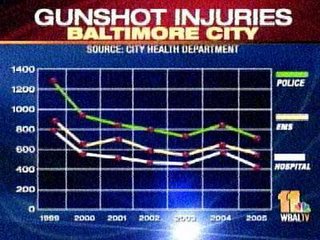Lies, more lies, and the Baltimore Mayor's Damned Statistics - Day 13

An ongoing compilation of the coverage of Mayor O'Malley's use of false/misleading crime statistics."
On a scale of one to 10 -- . . . 10 being the best -- how would you characterize the accuracy of the city's crime reporting since 2000?" Mayor Martin O'Malley replies: "I would say we're somewhere north of a 9.8."
February 23, 2006
In the Baltimore Sun, Eric Siegel publishes a piece under Urbarn Chronicles entitled, "To some in city, crime statistics debate is meaningless." The piece quotes a "small, random" sample of leaders in crime-ridden neighborhoods on the issue of the funky numbers and the call for an audit. Again, there's much talk about the politics of the issue, but the article concludes with some important points...the preception of crime. Essentially, the community leaders see positive progress in reducing crime, but note that more needs to be done. "I'd give [crime-control efforts] a C-type rating" . . . The key questions the article ends with: "Are you safe in your home?" and "Are you safe when you walk out the door?" . . . One leader's answer "I feel safe in my home," but "Walking, I wouldn't want to do."
The problem with messing with the crime statistics is the misrepresentation of a problem as having been mostly taken care of which makes people want to divert resources to more pressing problems. Crime remains a big problem in Baltimore and the City needs more police officers on the streets so they can develop relationships with the communities they serve to properly fight the problem. Moving police around all the time detaches them from the community and they start hassling non-criminals in their efforts. This turns the community against the police and a vicious cycle ensues that makes policing more difficult.
Much Ado About Nothing? WBAL TV and Radio come out with stories about the City's health and fire department releasing statistics to support the police departments statistics. WBAL Radio reports about a report from these City Departments reviewing data measuring homicides and shootings from 1999 until 2005. Police statistics say that gun-related homicides and non-fatal shootings dropped 39%; based on ambulance calls, the City Fire Department reports a 34% drop in gun-related calls; based on info from two hospitals, the health department says that gunshot injuries dropped 34.1% during that period. I wonder what those criminologists say about this? The report ends with notes that this does not include rapes because those may be reported to private doctors. There's no information on reports of robberies or property crimes. Former Commissioner Clark wanted an audit on property crimes, but current Commissioner Hamm doesn't think it's possible.
WBAL TV has Lowell Melser report on the story (Jayne Miller must have been busy doing actual investigation for her reporting instead of relying on press releases). The report includes this quote, "Our conclusion was that the data trends from the 911 calls and the hospital trauma services are consistent, remarkably similar to what the police have reported for gun-related violence," Baltimore City Health Commissioner Dr. Joshua Sharfstein said." Interestingly, the report includes a cool chart (above) comparing the figures. The discrepancies between the numbers is rather consistent from 2001 to 2005. The police statistics in 1999 and 2000, however, are compartively a lot higher. Why is that?
The City's health and fire department report is here. The report says that all gunshot injuries at the two hospitals declined by 32.2% from 1999 to 2005. I wonder why this number is different than the 34.1% WBAL radio reported. In any case, the police reported a 39% decline. That seems like a significant misrepresentation to me. The problem has never been whether crime has reduced in Baltimore since 1999; the problem is whether O'Malley was using false or misleading statistics to inflate his accomplishments. It's a question of credibility. We don't need a politician with the credibility issues that the White House has, running the State of Maryland, especially without a legislature of the opposite party to keep them in check.
WJZ TV has a short report on the story.

0 Comments:
Post a Comment
<< Home